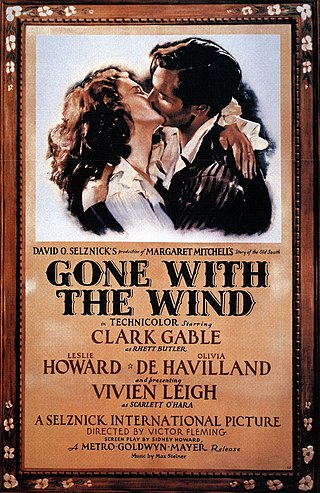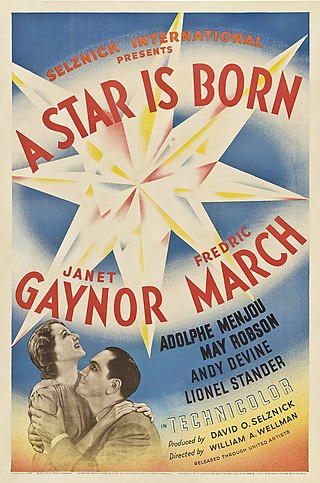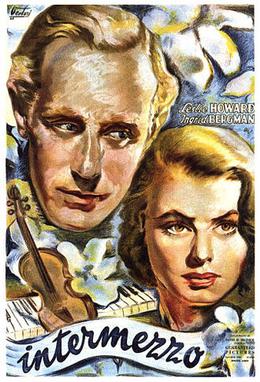
George Dewey Cukor was an American film director and producer. He mainly concentrated on comedies and literary adaptations. His career flourished at RKO when David O. Selznick, the studio's Head of Production, assigned Cukor to direct several of RKO's major films, including What Price Hollywood? (1932), A Bill of Divorcement (1932), Our Betters (1933), and Little Women (1933). When Selznick moved to Metro-Goldwyn-Mayer in 1933, Cukor followed and directed Dinner at Eight (1933) and David Copperfield (1935) for Selznick, and Romeo and Juliet (1936) and Camille (1936) for Irving Thalberg.

David O. Selznick was an American film producer, screenwriter and film studio executive who produced Gone with the Wind (1939) and Rebecca (1940), both of which earned him an Academy Award for Best Picture. He also won the Irving Thalberg Award at the 12th Academy Awards, Hollywood's top honor for a producer, in recognition of his shepherding Gone with the Wind through a long and troubled production and into a record-breaking blockbuster.

Gregory La Cava was an American film director of Italian descent best known for his films of the 1930s, including My Man Godfrey and Stage Door, which earned him nominations for Academy Award for Best Director.

Constance Campbell Bennett was an American stage, film, radio, and television actress and producer. She was a major Hollywood star during the 1920s and 1930s; during the early 1930s, she was the highest-paid actress in Hollywood. Bennett frequently played society women, focusing on melodramas in the early 1930s and then taking more comedic roles in the late 1930s and 1940s. She is best remembered for her leading roles in What Price Hollywood? (1932), Bed of Roses (1933), Topper (1937), Topper Takes a Trip (1938), and had a prominent supporting role in Greta Garbo's last film, Two-Faced Woman (1941).

Val Lewton was a Ukrainian-American novelist, film producer and screenwriter best known for a string of low-budget horror films he produced for RKO Pictures in the 1940s. His son, also named Val Lewton, was a painter and exhibition designer.

A Bill of Divorcement is a 1932 American pre-Code drama film directed by George Cukor and starring John Barrymore and Katharine Hepburn in her film debut. It is based on the 1921 British play of the same name, written by Clemence Dane as a reaction to a law passed in Britain in the early 1920s that allowed insanity as grounds for a woman to divorce her husband. It was the second screen adaptation of the play; the first was a 1922 British silent film also titled A Bill of Divorcement. The film was made again in 1940 by RKO Pictures.
John Cromwell was an American film and stage director and actor. His films spanned the early days of sound to film noir in the early 1950s, by which time his directing career was almost terminated by the Hollywood blacklist.

Little Women is a 1933 American pre-Code drama film directed by George Cukor, and starring Katharine Hepburn, Joan Bennett, Frances Dee, and Jean Parker. The screenplay, written by Sarah Y. Mason and Victor Heerman, is based on the 1868-1869 two-volume novel of the same name by Louisa May Alcott.

Gone with the Wind is a 1939 American epic historical romance film adapted from the 1936 novel by Margaret Mitchell. The film was produced by David O. Selznick of Selznick International Pictures and directed by Victor Fleming. Set in the American South against the backdrop of the Civil War and the Reconstruction era, the film tells the story of Scarlett O'Hara, the strong-willed daughter of a Georgia plantation owner, following her romantic pursuit of Ashley Wilkes, who is married to his cousin, Melanie Hamilton, and her subsequent marriage to Rhett Butler.

A Star Is Born is a 1937 American Technicolor drama film produced by David O. Selznick, directed by William A. Wellman from a script by Wellman, Robert Carson, Dorothy Parker, and Alan Campbell, and starring Janet Gaynor as an aspiring Hollywood actress, and Fredric March as a fading movie star who helps launch her career. The supporting cast features Adolphe Menjou, May Robson, Andy Devine, Lionel Stander, and Owen Moore. At the 10th Academy Awards, it became the first color film to be nominated for the Academy Award for Best Picture.

Intermezzo is a 1939 American romantic film remake of a 1936 Swedish film of the same title. It stars Leslie Howard as a married virtuoso violinist who falls in love with his accompanist, played by Ingrid Bergman in her Hollywood debut. The film was directed by Gregory Ratoff and produced by David O. Selznick. It features multiple orchestrations of Heinz Provost's title piece, which won a contest associated with the original film's production. The screenplay by George O'Neil was based on that of the original film by Gösta Stevens and Gustaf Molander. It was produced by Selznick International Pictures.

Gregory Ratoff was a Russian-American film director, actor and producer. As an actor, he was best known for his role as producer "Max Fabian" in All About Eve (1950).

Alice Adams is a 1935 romantic drama film directed by George Stevens and starring Katharine Hepburn. It was made by RKO and produced by Pandro S. Berman. The screenplay was by Dorothy Yost, Mortimer Offner, and Jane Murfin. The film was adapted from the novel Alice Adams by Booth Tarkington. The music score was by Max Steiner and Roy Webb, and the cinematography by Robert De Grasse. The film received Academy Award nominations for Best Picture and Best Actress.

Our Betters is a 1933 American pre-Code satirical comedy film directed by George Cukor and starring Constance Bennett, Anita Louise and Gilbert Roland. The screenplay by Jane Murfin and Harry Wagstaff Gribble is based on the 1917 play of the same title by Somerset Maugham. Tommy Atkins worked as assistant director, while the sets were designed by the art director Van Nest Polglase.

Rockabye is a 1932 American pre-Code drama film starring Constance Bennett, Joel McCrea, and Paul Lukas. The final version was directed by George Cukor after studio executives decided that the original film as directed by George Fitzmaurice was unreleasable. The screenplay by Jane Murfin is based on an unpublished play written by Lucia Bronder, based on her original short story.
Katharine "Kay" Brown Barrett was a Hollywood talent scout and agent beginning in the 1930s. She is most famous for bringing Margaret Mitchell's novel Gone with the Wind to the attention of David O. Selznick, for whom she worked, in 1936. She had a long career as representative, talent scout and agent with Leland Hayward, MCA and International Creative Management ("ICM").

Jane Murfin, née Macklem was an American playwright and screenwriter. The author of several successful plays, she wrote some of them with actress Jane Cowl—most notably Smilin' Through (1919), which was adapted three times for motion pictures. In Hollywood Murfin became a popular screenwriter whose credits include What Price Hollywood? (1932), for which she received an Academy Award nomination. In the 1920s she lived with Laurence Trimble, writing and producing films for their dog Strongheart, the first major canine star.
Rowland Brown, born Chauncey Rowland Brown in Canton, Ohio, was an American screenwriter and film director, whose career as a director ended in the early 1930s after he started many more films than he finished. He walked out of State's Attorney (1932), starring John Barrymore. He was abruptly replaced as director of The Scarlet Pimpernel.

The Common Law is a 1931 American pre-Code romantic drama film directed by Paul L. Stein, produced by Charles R. Rogers and starring Constance Bennett and Joel McCrea. Based on Robert W. Chambers' 1911 novel of the same name, the film was the third film adaptation of the book, and the first during the sound-film era. It was received well both at the box office and by film critics, becoming one of RKO's most financially successful films of the year.

Symphony of Six Million is a 1932 American Pre-Code drama film directed by Gregory La Cava and starring Ricardo Cortez, Irene Dunne and Gregory Ratoff. Based on the story Night Bell by Fannie Hurst, the film concerns the rise of a Jewish physician from humble roots to the top of his profession and the social costs of losing his connection with his community, his family and with the craft of healing.


















